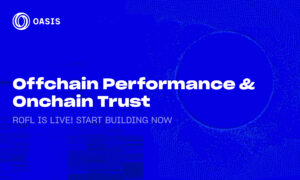“We’re still so early!”
These words have become something of a mantra in Web3 circles. And not without good reason—the entire space is currently about a third the size of Apple in market capitalization. Although it’s increasing by the month, the number of Web3 dApps is small when compared to their Web2 counterparts (Google Play alone hosts upwards of 3.5 million).
Yet, things are beginning to change. Big companies—which move at a glacial pace in contrast to the speed of Web3 platforms—have begun to establish a notable presence in the blockchain realm.
Sure, many of their moves into Web3 are humorous marketing stunts or attempts to capitalize on the hype. No one would deny that. After all, these companies have to begin somewhere. So, it’s no surprise that we’re seeing many major brands trying their hands with NFTs, virtual land, and social tokens.
All of this, however, is just the tip of the iceberg. The industry is showing real signs of maturation. Last month, we witnessed an impressive case of real estate being sold via an NFT-enabled contract. Yes, we’re still early, but it’s remarkable that—right before our eyes—Defi is extending its reach beyond crypto trading and exerting an influence in “real-world” affairs.
Of course, you might think all of this is just another marketing ploy.
Yet, as more real-world assets become tokenized, traditional market leaders are thinking the opposite: Web3 is not simply a marketing fad but will become a crucial part of their business’s development in the future.
It’s one thing to say real-world assets can be digitized and brought onto the blockchain, but it’s entirely something else to say they should be digitized. Indeed, as they say, “An is does not imply an ought.”
So, are there good reasons to digitize real-world assets? Well, yes, of course!
Let’s look at why…
Data is fragile
Perennial problems with safeguarding important information and documents stemming from the twin risks of error and decay. Yet, we’re at a stage in history in which we can protect the integrity of data against these risks as never before. Not only that, but blockchain technology also provides a vital element: decentralization.
An integral aspect of the development of societies is not just the production but also the collection of information—from tangibles such as land ownership to intangibles such as trade agreements and even beliefs and sciences. It’s hard to overstate how vital records are for maintaining stability and a reliable account of our past.
But such records are extremely fragile. It’s easy to forget this!
We have extensive information on the past, but so much has also been lost, not just to upheavals (like the burning of the library of Alexandria or the book burnings by the first emperor of China) but also to simple decay and neglect. Documents get wet, moldy, lost, and so on. We may take for granted the constant flow of data and access to information that shapes our lives, but these are neither eternal nor unassailable.
And we’re not just talking about data or records of global historical importance, but personal information as well, like contracts, receipts, proofs, and other legal documents. Sure, many physical records have made the move to the digital space. This is a great improvement: since the advent of the internet and cloud computing, the probability of assets surviving data losses has increased tremendously. However, most public records exist either physically or only in a few public servers—and not in well-supported, distributed networks that are more immune to faulty logic and widespread error.
This is a problem—one that the blockchain can help amend.
The benefits of Web3 record keeping
The structured survival of information is not something that simply happens. It isn’t something that occurs without care and planning. In particular, the long-term survival of data relies on our tapping into new potentials provided by technology. Cloud storage is an excellent example: it makes it possible to access and share information with speed and efficiency that would have been unthinkable half a century ago.
Already, though, blockchain technology adds a vital element: decentralization. Decentralization helps avoid risks associated with centralized points of failure. This is not only true for large-scale data records but also smaller local or personal needs.
There are several reasons this is a major improvement in keeping records of real-world assets.
First, blockchain technology allows us to seamlessly track, trade, or exchange assets with near zero risk of data loss (e.g., from error or tampering). A fundamental fact about blockchain transactions is that they’re a matter of public record, searchable and confirmable by any interested party. An event on the blockchain provides all the proof necessary to confirm actions taken or deals made, or, importantly, to deny false accusations or circumstances!
Second, having geographical and technological fail-safes is essential for the accessibility and archiving of knowledge. Web3 solutions have a clear advantage in this regard. They offer options another tech cannot. For example, they not only provide open queryable data layers for us to use as ledgers of records but also allow us to easily locate exactly what we are searching for, no matter where it sits in the history of the chain.
Thus, by utilizing Web3’s advances over Web2 systems, we can solve critical storage and rediscovery issues other mediums face. Perhaps more importantly, we also go far to avoid the perennial problems of error and decay when it comes to safeguarding important information and documents. Since they are decentralized and available to any interested party, blockchain transactions remain stable on the chain, the details of which can be confirmed by all.
Digitizing real-world assets
So, what can we do with this technology in the “real world”?
Let’s return to the case of real estate transactions. Typically, we view property in real life, sign a contract, update the land deeds with the local authority for records, etc. Most often, this goes off without a hitch. But we also hear of horror cases of parties impersonating the owner to sell a property, of bribing or gaining access to records to change things, and of human error leading to poor or wrong records, thereby causing inheritance or tax problems in the future.
By digitizing our real-world assets, we aren’t changing the core components of the experience: you’d still view property in real life, sign a contract, and so on. However, you would avoid all the risks described above!
By relying on the blockchain to serve as further proof of record, we’re protecting our information for posterity, enhancing the integrity of real-life assets, and making tracking and retrieval easier. All of this applies not only to cases like real estate transactions but will also revolutionize how we deal with passports, personal IDs, financing documentation, memberships and ticketing, corporate bonds, and more—it’s just limited by our imaginations!
Yes, we are still so early.
But by now, the foundation is in place. It’s time we begin taking full advantage of the future we’ve built.



































